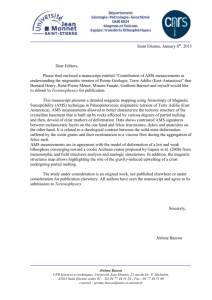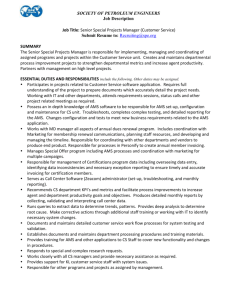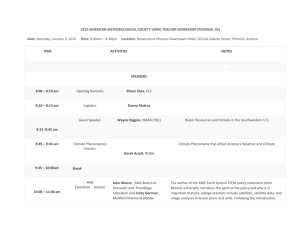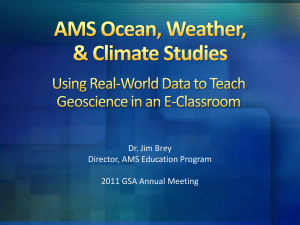AMS AMS AMS Undergraduate ( Courses
advertisement
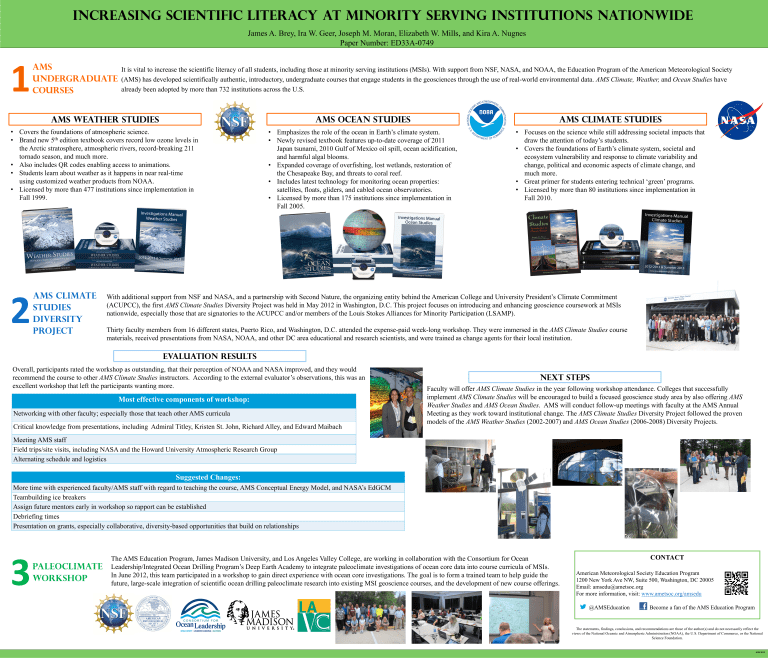
INCREASING SCIENTIFIC LITERACY AT MINORITY SERVING INSTITUTIONS NATIONWIDE James A. A Brey, Bre Ira W. W Geer Geer, Joseph M. M Moran, Moran Elizabeth Eli abeth W. W Mills Mills, and Kira A. A Nugnes N gnes P p Number: Paper N b ED33A ED33A-0749 0749 AMS Undergraduate Courses I is It i vital i l to increase i the h scientific i ifi li literacy y off all ll students students, d including i l di g those h at minority i i y serving i g institutions i i i ((MSIs). (MSIs) (MSI ) With Wi h support pp from f NSF NSF, NASA NASA, and d NOAA NOAA, the h Ed Education i P Program g off the h A American i M Meteorological l gi l S Society i y ((AMS)) has developed p scientifically y authentic, authentic, introductory, introductory y, undergraduate g courses that engage g g students in the ggeosciences through g the use of real-world real world environmental data. data AMS Climate Climate,, Weather Weather,, and Ocean Studies have already l d been b adopted d t d by b more th than 732 iinstitutions tit ti across th the U U.S. S AMS Weather Studies AMS ocean Studies AMS climate Studies • Covers the foundations of atmospheric p science science. • Brand new 5thh edition textbook covers record low ozone levels in the h Arctic A i stratosphere stratosphere, h atmospheric h i rivers rivers, i record-breaking d b ki 211 t tornado d season season, and d much h more. more • Also Al includes i l d QR codes d enabling bli access tto animations. i ti • Students learn about weather as it happens pp in near real real-time time using g customized weather pproducts from NOAA. NOAA • Licensed Li d by by more than h 477 institutions i i i since i iimplementation pl i in i F ll 1999. Fall 1999 • Emphasizes p the role of the ocean in Earth Earth’ss climate system. system y • Newly y revised textbook features up up-to-date p to date coverage g of 2011 Japan p tsunami, tsunamii 2010 Gulf G lf off Mexico i oil il spill, spill pill ocean acidification acidification, idifi i and d hharmful f l algal l l blooms. bl blooms • Expanded E d d coverage off overfishing, fi hi lost l t wetlands, tl d restoration t ti off the Chesapeake Bay Bay, and threats to coral reef reef. • Includes latest technology gy for monitoringg ocean pproperties: p satellites satellites, lli , floats fl floats,, gliders ggliders, lid , andd cabled bl d ocean observatories observatories. b i • Licensed Li d by b more than h 175 institutions i i i since i iimplementation l i in i F ll 2005 Fall 2005. • Focuses on the science while still addressing g societal impacts p that draw the attention of today’s today y s students. students • Covers C the h ffoundations d i off Earth Earth’s h’s climate li system system, y societal i l and d ecosystem t vulnerability l bilit and d response tto climate li t variability i bilit andd change, h political liti l and d economic i aspects t off climate li t change, h and d much more. more • Great pprimer for students enteringg technical ‘green’ ggreen pprograms. programs g • Licensed i d by by more than h 80 institutions i i i since i iimplementation pl i in i F ll 2010. Fall 2010 A S Climate AMS C at St Studies s Diversity st Project ct With additional dditi l supportt from f NSF andd NASA NASA, andd a partnership t hi with ith Second S d Nature N Nature, t the th organizing i i entity tit behind b hi d the th American A i College C ll andd University U i it P President’s President id t’s Cli Climate t C Commitment it t (ACUPCC) the (ACUPCC), th fi firstt AMS Climate Cli t Studies St di Diversity Di it Project P j t was held h ld iin M May 2012 iin W Washington, hi t D.C. D C This Thi project j t focuses f on introducing i t d i andd enhancing h i geoscience i coursework k att MSI MSIs nationwide, especially nationwide, p y those that are signatories g to the ACUPCC and/or members of the Louis Stokes Alliances for Minority y Participation p ((LSAMP) (LSAMP). ) Thi y faculty Thirty f l y members b from f 16 different diff states states, Puerto P Rico Ri Rico, and dW Washington Washington, hi g D D.C. C attended d d the h expense-paid p p id week-long k l g workshop. workshop k h p They Th y were immersed i d in i the h AMS Climate Cl Studies S d course materials materials, t i l received i d presentations t ti ffrom NASA NASA, NOAA NOAA, andd other th DC area educational d ti l and d research h scientists, scientists i ti t and d were ttrained i d as change h agents t ffor th their i llocall iinstitution institution. tit ti Evaluation results O erall participants rated the workshop Overall, orkshop as ooutstanding, tstanding that their perception of NOAA and NASA impro improved, ed and the they would o ld recommend the course to other AMS Climate Studies instructors. instructors Accordingg to the external evaluator’s evaluator s observations observations,, this was an excellent workshop p that left the pparticipants p wanting g more more. M t effective Most ff ti components t off workshop: kh N t Networking ki with ith other th faculty; f lt especially i ll th those th thatt tteach h other th AMS curricula i l Critical knowledge g from ppresentations presentations,, including g Admiral Titley, Titley y, Kristen St. St John John,, Richard Alley, Alley y, and Edward Maibach Next steps Faculty y will offer AMS Climate Studies in the year y followingg workshop p attendance attendance. Colleges g that successfully y i pl implement AMS Climate Cl Studies S d will ill be b encouraged g d to bbuild ild a focused f d ggeoscience i study dy area bby y also l offering ff i g AMS W h SStudies Weather di and d AMS Ocean O SStudies. Studies di AMS will ill conduct d t ffollow-up follow ll up meetings ti with ith ffaculty lt att th the AMS Annual A l M ti as th Meeting they work k ttoward d iinstitutional tit ti l change. h Th The AMS Climate Cli t Studies St di Diversity Di it Project P j t followed f ll d the th proven models of the AMSS Weather W Studies S (2002 2007)) and AMS ((2002-2007) SO Ocean SStudies ((2006-2008) (2006 2008)) Diversity y Projects. Projects j M ti AMS staff Meeting t ff Fi ld trips/site Field i / i visits visits, i i including i l di NASA andd the h Howard H d University U i i Atmospheric A h i Research R hG Group Alternating g schedule and logistics g Suggested Changes: M More time i with i h experienced p i d faculty/AMS f l y/AMS staff ff with i h regard g d to teaching hi g the h course course, AMS C Conceptual p lE Energy gy M Model Model, d l and d NASA’ NASA’s NASA s EdGCM Teambuilding g ice breakers Assign future f t re mentors early earl in workshop orkshop so rapport can be established D b i fi ti Debriefing times Presentation on ggrants grants,, especially p y collaborative collaborative,, diversity diversity-based y based opportunities pp that build on relationships p Paleoclimate workshop The AMS Education Program, Program g , James Madison University, University y, and Los Angeles g Valleyy College, College g , are workingg in collaboration with the Consortium for Ocean Leadership/Integrated d hip/ g d Ocean Drilling illi g Program Program’s g s Deep p Earthh Academy d y to integrate i g ppaleoclimate l li i investigations ig i off ocean core ddata into i course curricula i l off MSIs MSIs. I June In J 2012 2012, this hi team participated i i d iin a workshop k h to gain i di direct experience i with i h ocean core investigations. iinvestigations i i The Th goall iis to fform a trained i d team to hhelp l guide id the h f t future, large-scale llarge scale l iintegration t ti off scientific i tifi ocean ddrilling illi paleoclimate l li t research h iinto t existing i ti MSI geoscience i courses, and d th the ddevelopment l t off new course offerings. ff i CONTACT American Meteorological g Society y Education Program g 1200 00 N New Y York o kA Ave ve NW NW, S Su Suite itte 500 500, W Was Washington, hi gto t , DC C 20005 0005 Email: il amsedu@ametsoc.org amsedu@ametsoc d @ org For more information, information, visit: www.ametsoc.org/amsedu www ametsoc org/amsedu g @AMSEducation Become a fan of the AMS Education Program The statements, statements findings, findings conclusions, conclusions and recommendations are those of the author(s) and do not necessarily reflect the views of the National Oceanic and Atmospheric Administration (NOAA), the U.S. Department of Commerce, or the National S i Science F Foundation. d ti AGU 2012


